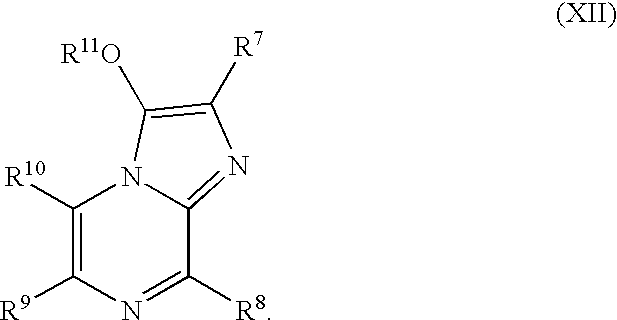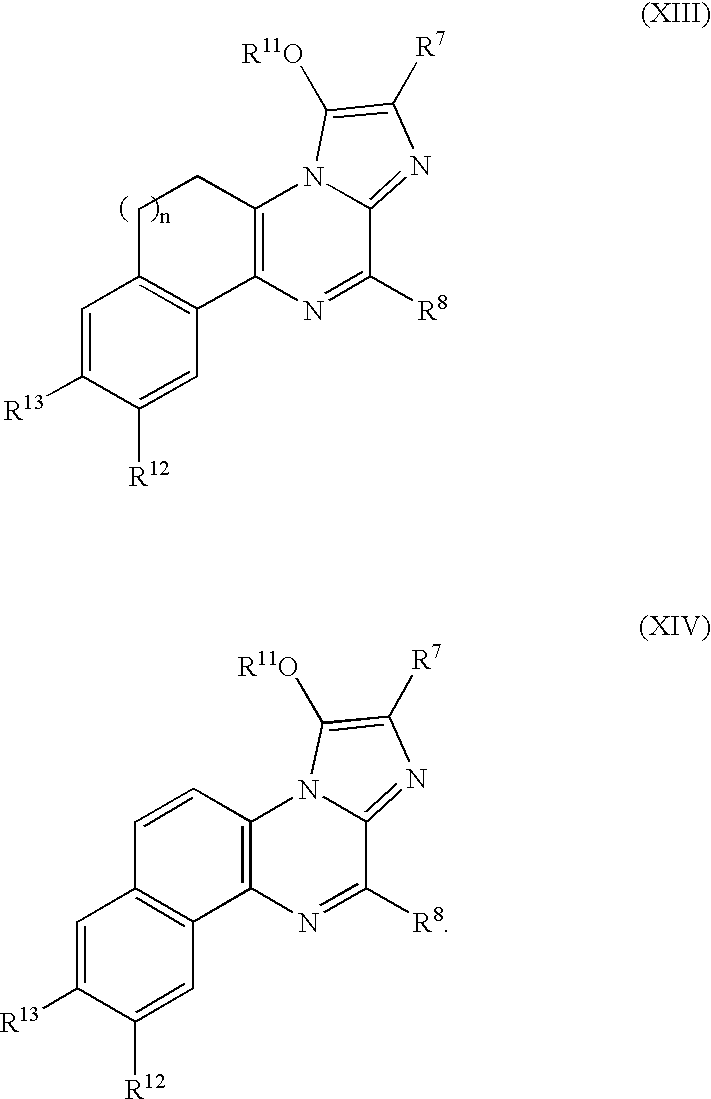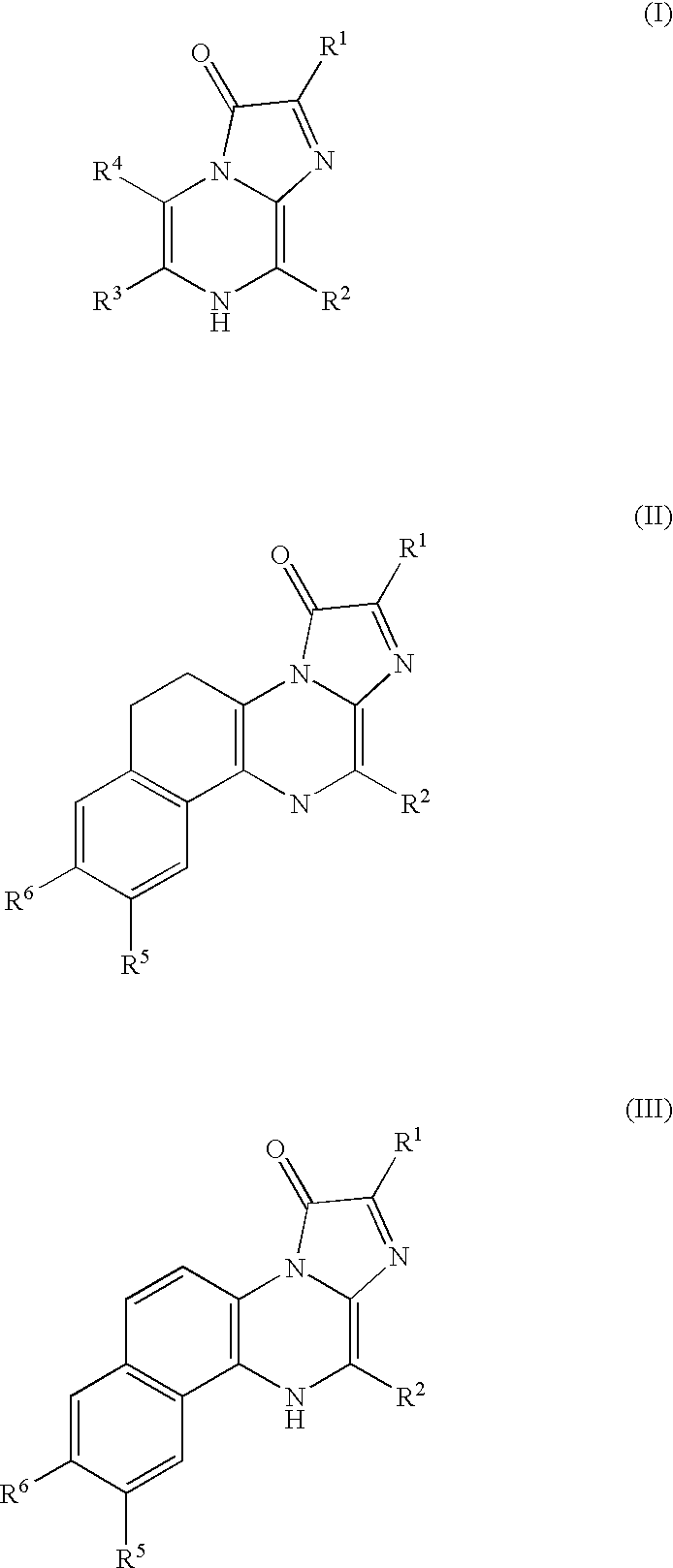Compositions and methods to co-localize luminophores with luminescent proteins
- Summary
- Abstract
- Description
- Claims
- Application Information
AI Technical Summary
Benefits of technology
Problems solved by technology
Method used
Image
Examples
example no.1
Example No. 1
[0083] In this example, a protected luminophore bearing three acetyl protecting groups was synthesized from a coelenterazine having the structure VI. To a solution of compound VI (STOP AND GLO.RTM. SUBSTRATE, PROMEGA CORPORATION) (500 mg; 1.2 mM) in anhydrous pyridine (20 ml) was added acetic anhydride (1.1 ml; 12 mM), and the reaction was kept under an inert atmosphere at room temperature. After 1 hour, 30 ml of CH.sub.2Cl.sub.2 was added to the reaction, followed by 80 ml H.sub.2O. This mixture was stirred for 5 minutes, and then the layers were separated. The organic layer was evaporated to dryness and then purified by column chromatography as follows. Normal phase silica (20 g) was solvated in CH.sub.2Cl.sub.2 and loaded into an appropriate sized glass column. The extracted reaction mixture was taken up in a minimum of CH.sub.2Cl.sub.2 and applied to the top of the column. A step gradient was employed, starting at 1% ethyl acetate (EtOAc) in CH.sub.2Cl.sub.2 and inc...
example no.2
Example No. 2
[0084] In this example, a protected luminophore bearing three butyryl protecting groups was synthesized from a coelenterazine having the structure VI. To a solution of compound VI (300 mg; 0.7 mM) in anhydrous pyridine (30 ml) was added butyric anhydride (1.12 g; 7 mM), and the reaction was allowed to sit under an inert atmosphere at room temperature. After 1 hour, the reaction mixture was placed under vacuum in order to remove the solvent until a syrup was formed. To the syrup was added 30 ml CH.sub.2Cl.sub.2, followed by 80 ml H.sub.2O. This mixture was stirred for 5 minutes, and then the layers were separated. The organic layer was then evaporated to dryness and then purified by column chromatography as follows. Normal phase silica (20 g) was solvated with 2% EtOAc in CH.sub.2Cl.sub.2 and loaded into an appropriate sized glass column. The extracted reaction mixture was taken up in minimum of CH.sub.2Cl.sub.2 and applied to the top of the column. The mobile phase was ...
example no.3
Example No. 3
[0085] In this example, a coelenterazine having structure VII was synthesized. The synthesis procedure was a modification of that reported by Inoue et al. (Inoue and Kakoi,Heterocycles 48(8), 1669 (1998)). To a solution of 2-amino-3-benzyl-5(4-hydroxyphenyl)pyrazine (2 g, 7.2 mM) in xylenes (80 mL) was added phenylpyruvic acid (8.3 g, 50.5 mM) all at once, and the reaction mixture was heated at reflux (130-140.degree. C.) for 1 hr and then cooled to room temperature. The mixture was evaporated under reduced pressure to a dark solid foam. This foam was separated by chromatography on 300 g of N.P. silica with step gradient of methanol in CH.sub.2Cl.sub.2. The desired product eluted with 5% methanol in CH.sub.2Cl.sub.2to yield 2 g of compound VII, which was 80% pure by HPLC. This chromatography was repeated to yield 900 mg of compound VII ("coelenterazine-h", >95% by HPLC) as a brown solid.
PUM
| Property | Measurement | Unit |
|---|---|---|
| Fraction | aaaaa | aaaaa |
| Temperature | aaaaa | aaaaa |
| Fraction | aaaaa | aaaaa |
Abstract
Description
Claims
Application Information
 Login to View More
Login to View More - R&D
- Intellectual Property
- Life Sciences
- Materials
- Tech Scout
- Unparalleled Data Quality
- Higher Quality Content
- 60% Fewer Hallucinations
Browse by: Latest US Patents, China's latest patents, Technical Efficacy Thesaurus, Application Domain, Technology Topic, Popular Technical Reports.
© 2025 PatSnap. All rights reserved.Legal|Privacy policy|Modern Slavery Act Transparency Statement|Sitemap|About US| Contact US: help@patsnap.com



